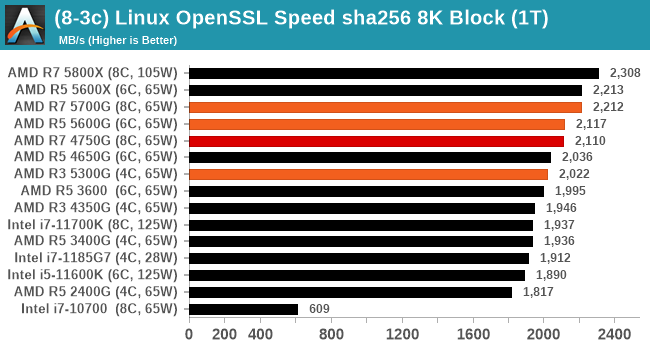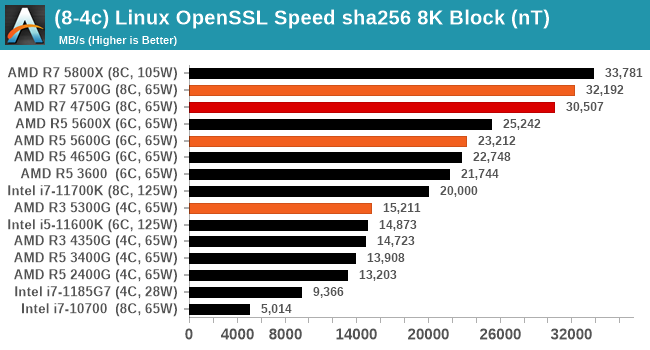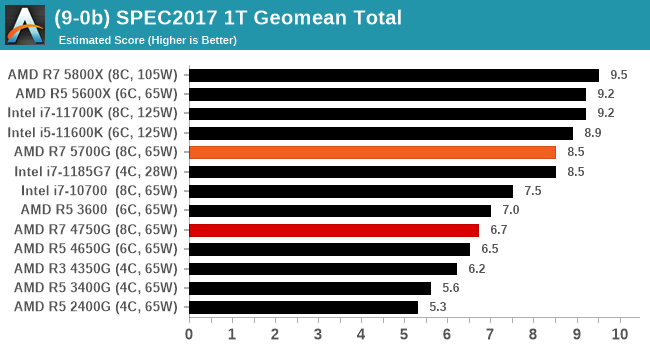The AMD Ryzen 7 5700G, Ryzen 5 5600G, and Ryzen 3 5300G Review
by Dr. Ian Cutress on August 4, 2021 1:45 PM ESTCPU Tests: Synthetic
Most of the people in our industry have a love/hate relationship when it comes to synthetic tests. On the one hand, they’re often good for quick summaries of performance and are easy to use, but most of the time the tests aren’t related to any real software. Synthetic tests are often very good at burrowing down to a specific set of instructions and maximizing the performance out of those. Due to requests from a number of our readers, we have the following synthetic tests.
Linux OpenSSL Speed: SHA256
One of our readers reached out in early 2020 and stated that he was interested in looking at OpenSSL hashing rates in Linux. Luckily OpenSSL in Linux has a function called ‘speed’ that allows the user to determine how fast the system is for any given hashing algorithm, as well as signing and verifying messages.
OpenSSL offers a lot of algorithms to choose from, and based on a quick Twitter poll, we narrowed it down to the following:
- rsa2048 sign and rsa2048 verify
- sha256 at 8K block size
- md5 at 8K block size
For each of these tests, we run them in single thread and multithreaded mode. All the graphs are in our benchmark database, Bench, and we use the sha256 results in published reviews.


GeekBench 5: Link
As a common tool for cross-platform testing between mobile, PC, and Mac, GeekBench is an ultimate exercise in synthetic testing across a range of algorithms looking for peak throughput. Tests include encryption, compression, fast Fourier transform, memory operations, n-body physics, matrix operations, histogram manipulation, and HTML parsing.
I’m including this test due to popular demand, although the results do come across as overly synthetic, and a lot of users often put a lot of weight behind the test due to the fact that it is compiled across different platforms (although with different compilers).
We have both GB5 and GB4 results in our benchmark database. GB5 was introduced to our test suite after already having tested ~25 CPUs, and so the results are a little sporadic by comparison. These spots will be filled in when we retest any of the CPUs.


CPU Tests: SPEC
SPEC2017 and SPEC2006 is a series of standardized tests used to probe the overall performance between different systems, different architectures, different microarchitectures, and setups. The code has to be compiled, and then the results can be submitted to an online database for comparison. It covers a range of integer and floating point workloads, and can be very optimized for each CPU, so it is important to check how the benchmarks are being compiled and run.
We run the tests in a harness built through Windows Subsystem for Linux, developed by our own Andrei Frumusanu. WSL has some odd quirks, with one test not running due to a WSL fixed stack size, but for like-for-like testing is good enough. SPEC2006 is deprecated in favor of 2017, but remains an interesting comparison point in our data. Because our scores aren’t official submissions, as per SPEC guidelines we have to declare them as internal estimates from our part.
For compilers, we use LLVM both for C/C++ and Fortan tests, and for Fortran we’re using the Flang compiler. The rationale of using LLVM over GCC is better cross-platform comparisons to platforms that have only have LLVM support and future articles where we’ll investigate this aspect more. We’re not considering closed-sourced compilers such as MSVC or ICC.
clang version 10.0.0
-Ofast -fomit-frame-pointer
-march=x86-64
-mtune=core-avx2
-mfma -mavx -mavx2
Our compiler flags are straightforward, with basic –Ofast and relevant ISA switches to allow for AVX2 instructions. We decided to build our SPEC binaries on AVX2, which puts a limit on Haswell as how old we can go before the testing will fall over. This also means we don’t have AVX512 binaries, primarily because in order to get the best performance, the AVX-512 intrinsic should be packed by a proper expert, as with our AVX-512 benchmark. All of the major vendors, AMD, Intel, and Arm, all support the way in which we are testing SPEC.
To note, the requirements for the SPEC licence state that any benchmark results from SPEC have to be labelled ‘estimated’ until they are verified on the SPEC website as a meaningful representation of the expected performance. This is most often done by the big companies and OEMs to showcase performance to customers, however is quite over the top for what we do as reviewers.
For each of the SPEC targets we are doing, SPEC2006 1T, SPEC2017 1T, and SPEC2017 nT, rather than publish all the separate test data in our reviews, we are going to condense it down into a few interesting data points. The full per-test values are in our benchmark database.



We’re still running the tests for the Ryzen 5 5600G and Ryzen 3 5300G, but the Ryzen 7 5700G scores strong.










135 Comments
View All Comments
Dribble - Friday, August 6, 2021 - link
Might be because it isn't as power limited and hence won't throttle in the same way the AMD chip.Danvelopment - Thursday, August 5, 2021 - link
Is the 5600G 6 core or 8 core? The first page of the article says it's both on the two tables.eastcoast_pete - Thursday, August 5, 2021 - link
Now, imagine if those 5700 APUs would have kept the core numbers of the 3400, but clocked at current speeds. I hope that Intel will bring its 10 nm Desktop CPUs with the full Xe compliment of mobile Tiger Lake, as that might force AMD to up its game; well, the next APU generation will be RDNA2, so as long as AMD doesn't gimp it by keeping the GPU tiny, it should have significant uplift over CézanneCooe - Friday, August 6, 2021 - link
Far Cry 5 running at ≈25fps on average at "1080p Ultra" is actually CRAZY freaking impressive. Why? Because that means it should hit a solid >=30fps running at "1080p High", which basically means that this single chip APU solution is outperforming BOTH of the last generation console base models (aka PS4 & Xbox One/S) in this title!!! That's freaking NUTS!!!nandnandnand - Tuesday, August 10, 2021 - link
I wouldn't be surprised to see 1080p60 in the same scenarios with Rembrandt next year. But DDR5 will be expensive.nanonan - Friday, August 6, 2021 - link
Every other source I've read states the pcie configuration as 24 lanes divided into 16, 4 and 4 just like the 4000G series. Do you have a source for this 8+4+8 configuration?linuxgeex - Friday, August 6, 2021 - link
Anand wasn't perfect with proofing either but he was thorough on deep dives, exposing bottlenecks and explaining how and why it was relevant. These days Ian and co assume that if we're Anandtech readers we just trust their methodology and do some lip service by adding cut&paste boilerplate around specs and throw in an image sometimes from a past review, sometimes not directly relevant, and I get that they only have so much time to invest. It bores me, and it doesn't give the new people the same level of engagement that will built their future audience. Oh welles.Samus - Friday, August 6, 2021 - link
I blacked out after getting to the part where an entry-level AMD APU starts at $259.While I get yes there are the Athlon's, they are mostly outclassed by a 9th gen $90 Intel Core i3 so it isn't even worth consideration.
GeoffreyA - Saturday, August 7, 2021 - link
Yes, pricing is disappointing.mode_13h - Sunday, August 8, 2021 - link
They're starting strong, because it's a lot easier to lower prices than raise them, and that pricing reflects the supply/demand situation, especially when the 3000-gen are still widely available.Over time, I'm sure you can expect to see the gap close, particularly since the process node is the same and die sizes are similar.